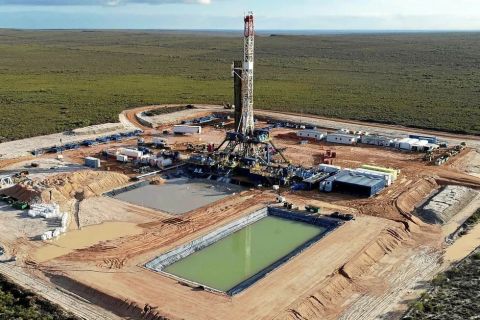Microbial enhanced oil recovery (MEOR) is the concept of using microbiological technology in oil reservoirs to improve the recovery of oil and gas trapped in the porous media of the formation. This technique of using nature to improve oil and gas production is an old and seldom-used technology. Through the ’80s and ’90s several formulations were used in an attempt to reduce viscosity, paraffins, and asphaltenes. The results were mixed. Not every oil or gas well treated showed improvement. This was primarily due to the nature of the microbes used at that time.
Microbial formulations of that period were simply not robust enough to thrive and grow in the varying conditions of the different oil and gas fields. Today this issue has been solved through long-term research in the study of cultures designed for survival in various crude and well conditions. Microbes have been selected from a variety of environments of hot sulfurous deposits, oil pits, underwater samples, river water, and sewage treatment plants and cultured to produce the most robust strains that can survive in a multitude of environments. Microbial formulations in 2012 are designed to survive in a large range of temperatures, acidity, crude composition, and viscosities. Current microbial solutions are proving to be consistent in improving well conditions and production rates.
New formulations
These new formulations use a combination of autotrophic, heterotrophic, aerobic, and anaerobic microbes. Autotrophic bacteria use inorganic materials as a source of nutrients, such as carbon dioxide and nitrogen. Heterotrophic bacteria metabolize organic materials, such as hydrocarbons (saturated and unsaturated), organic acids, and amines. Aerobic bacteria use dissolved oxygen in the respiratory process. Anaerobic bacteria live in the absence of oxygen by decomposing chemical species containing oxygen, such as sulfate, carbonate, phosphate, and nitrates.
This treatment has many advantages over conventional chemical treating and hot oiling. Primarily, the use of microbes reduces downtime, treating the root cause of the problem by digesting long-chain hydrocarbons while cleaving them into shorter molecules. Single-cell organisms proliferate and adapt quickly in the presence of asphaltenes and long-chain waxy paraffins while producing enzymes, surfactants, alcohols, and polysaccharides. The organisms are chosen to withstand high temperatures and pressures and to survive in a variety of conditions, including changing hydrocarbon compositions and acidities. This reduces downtime, treats the root issue, impacts the long-term viability of the well, has better economics, and is a sustainable green technology that does not require hazardous chemical storage or disposal.

TABLE 1. Crude composition often changes after treatment for 24 hours. (Data courtesy of Sepcor
Application
Administered downhole, the microbes are dispersed throughout the well bore and mixed with the produced fluids. As the regenerating biochemical multiplies, it resolubilizes crystallized paraffin/asphaltene molecules to prevent costly deposition. Paraffin/asphaltene also is resolubilized in surface equipment by inhibiting the formation of deposits throughout the pumping system, including flowlines, heaters, and storage tanks.

TABLE 2. Over a four-month period in a Wyoming oil field, production increased 68% after treatment
Changes to crude composition and properties are significant after treatment in 24 hours (Table 1). Typical gains in oil production through several test wells averaged a 25% increase in production over an untreated well (Table 2).
Microbial treatment of crude oil results in significant changes in composition and properties. The decrease in the viscosity, asphalt content, and cloud point leads to significant savings in production and pumping costs (Table 3).

TABLE 3. MEOR caused changes in crude composition and properties in this test.
The polysaccharides produced during treatment and colonization end up coating metallic surfaces. This produces a protective film over metal surfaces, protecting against corrosion. Water quality at knockouts went from 1,000 ppm with chemical treatments to 98 ppm with microbial treatments. Excess water was less than 10 ppm total petroleum hydrocarbons (TPH), easily conforming to Department of Environmental Quality discharge standards. Injection pressure was reduced by 10%, allowing an additional 1,500 b/d of water to be reinjected. Grind-outs at knockout went from 1.5% to 3% to less than 1%. Weight loss coupon measurement at knockout went from 5.5 mils per year (mpy, a measurement of lost thickness due to corrosion) to 1.5 mpy.
Microbes can be combined with chemical treating programs for corrosion and optimized for maximum protection. Though not compatible with quaternary amines, they are very compatible with gluteraldehydebased chemicals.
Other benefits of MEOR include reducing HS through digestion, encapsulation, and conversion to stable sulfur salts. In many cases, the effect is significant. In test cases, HS was reduced from 1,600 ppm to less than 100 ppm. Using specialized strains, oil spills, halogen-containing compounds, and TPH are controlled through the cleaving of hydrocarbons to smaller and smaller pieces.
Emulsions are broken by the strength of the microbes in the oil/water interface, surfactant production, and elimination of free oxygen. This happens through the reduction of surface tension at the oil/water interface by surfactants, cleaving of the naphthenic acid chain by digestion, reduction of interfacial tension between oil and water, and bacterial ingestion of salt. This effect either reduces or negates the need for costly demulsifiers in breaking tough emulsions. The product may be used in oil/water separators, weirs, or waste effluents or in any water/oil-water system where emulsions are a problem.
Microbial technology’s annual treating costs are low compared to a chemical treating program and produce many additional benefits. It can be part of a green and sustainable program with benefits of increasing production and extending the life of the wells.
Recommended Reading
Brett: Oil M&A Outlook is Strong, Even With Bifurcation in Valuations
2024-04-18 - Valuations across major basins are experiencing a very divergent bifurcation as value rushes back toward high-quality undeveloped properties.
Marketed: BKV Chelsea 214 Well Package in Marcellus Shale
2024-04-18 - BKV Chelsea has retained EnergyNet for the sale of a 214 non-operated well package in Bradford, Lycoming, Sullivan, Susquehanna, Tioga and Wyoming counties, Pennsylvania.
Triangle Energy, JV Set to Drill in North Perth Basin
2024-04-18 - The Booth-1 prospect is planned to be the first well in the joint venture’s —Triangle Energy, Strike Energy and New Zealand Oil and Gas — upcoming drilling campaign.
PGS, TGS Merger Clears Norwegian Authorities, UK Still Reviewing
2024-04-17 - Energy data companies PGS and TGS said their merger has received approval by Norwegian authorities and remains under review by the U.K. Competition Market Authority.
Energy Systems Group, PacificWest Solutions to Merge
2024-04-17 - Energy Systems Group and PacificWest Solutions are expanding their infrastructure and energy services offerings with the merger of the two companies.




